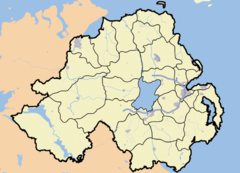Aghadrumsee: Difference between revisions
No edit summary |
No edit summary |
||
| Line 3: | Line 3: | ||
{{Infobox UK place | {{Infobox UK place | ||
|official_name= Aghadrumsee | |official_name= Aghadrumsee | ||
|irish_name= | |irish_name= Achadh Droim Saileach | ||
|scots_name= | |scots_name= | ||
|static_image= | |static_image= | ||
Revision as of 12:04, 20 October 2009
| Aghadrumsee | |
| Irish: Achadh Droim Saileach | |
Aghadrumsee shown within Northern Ireland | |
| Coordinates: 54°13′43″N 7°16′22″W / 54.2286°N 7.2728°W | |
| Irish grid reference | |
|---|---|
| District | Fermanagh |
| County | County Fermanagh |
| Constituent country | Northern Ireland |
| Sovereign state | United Kingdom |
| Post town | ENNISKILLEN |
| Postcode district | BT92 |
| Dialling code | 028 677 51 |
| Police | Northern Ireland |
| Fire | Northern Ireland |
| Ambulance | Northern Ireland |
| European Parliament | Northern Ireland |
| UK Parliament | Fermanagh and South Tyrone |
| NI Assembly | Fermanagh and South Tyrone |
| List of places: UK • Northern Ireland • Fermanagh | |
Aghadrumsee is a townland and a small village (aka Aghadrumsee Park) in South-Eastern County Fermanagh, Northern Ireland. This area was also been known as "Black Dog's Lane", in medieval times.
(Meaning of Aghadrumsee | Stories about Aghadrumsee)
Etymology
The earliest known spelling of Aghadrumsee is Aghadromsillagh. [1]
This is derived from the Gaelic Agha (field), [2] Drom (hillock), [2] Sillagh and roughly translates as 'field on the hillock of Sally trees'.
However the see syllable in the current spelling of Aghadrumsee is a homophone of sidhe. This gives Aghadrumsee its folklore meaning of 'field of the fairy hillock.'
For more detailed discussion, click here for the meaning of Aghadrumsee
Religion
Aghadrumsee comes under the Church of Ireland and Roman Catholic dioceses of Clogher. The parish of Aghadrumsee straddles the border town of Clones, County Monaghan in the Republic of Ireland.
The community is served by a number of churches, the two main ones being St. Mark's Church of Ireland and St. Macartan's Roman Catholic Chapel. There are a small number of gospel halls in the area.
-
St. Macartan's - Roman Catholic Chapel
-
St. Marks - Church of Ireland
Education
There are three primary schools, two Roman Catholic, Cornagague and Corranny, and one controlled – Aghadrumsee. All are sited in rural locations within three miles of each other and fall under the Western Education and Library Board (WELB) catchment area.
- Aghadrumsee Primary School - Controlled
- Cornagague Primary School - Council for Catholic Maintained Schools (CCMS)
- Corranny Primary School - Council for Catholic Maintained Schools (CCMS)
Historically, the current two storey building which is now attached to the orange hall was the old school at Aghadrumsee. In the Survey of Education in 1826 it was described as costing £120 and was funded by the Kildare Place Society. No figures for enrolment are given as it was not yet open.
The new school was built as a replacement in 1937. It was then enlarged and renovated in 1973-74 to take in children from Magheraveely and Roslea. The school now caters for children from a wide rural area.
Other schools in the local area, which are now closed, included Rateen National School.
Buildings of note
There is an Orange Hall at Aghadrumsee and another one at nearby Dromaddy. There are only two grocery shops (Dernawilt and Corranny) in the area and a solitary local public house (Corranny).
Sport
The area also has a Gaelic Athletic Club called St Macartans Aghadrumsee which provides sport for both men and women. The local badminton team has a good reputation for skillful players.
Administration
The area is in the political ward of Erne East and is represented by politicians from each of the four local parties, Democratic Unionist Party, Ulster Unionist Party, Sinn Féin and the Social Democratic and Labour Party.
Transport
Historically the town of Clones has had a significant influence on this rural community mainly due to the railway which used to go through it. The New Line.
Neighbouring townlands
Aghnachuill, Bosallagh, Crocknaboghill, Dernawilt, Drumswords, Killyfole, Killygorman, Killylacky, Mullynalughoge, Tattynageeragh
References
- ↑ Escheated Counties Map (1609)
- ↑ 2.0 2.1 "Gaelic Geographical Root Words for Irish Town Names". http://www.rootsweb.ancestry.com/~irlker/resgeoterm.html.


